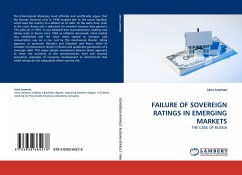The International Monetary Fund officially and unofficially argues that the Russian financial crisis in 1998 erupted due to the scarce liquidity, which lead the country to a default on its debt. At the same time, prior to the crisis, Russia was a seduction for investors because they gained a 150 yield on in 1997. It was believed that macroeconomic stability was taking roots in Russia since 1994 as inflation decreased, stock market was established and the stock index started to increase, and consumption was on a rise. Led by this neoclassical illusion, rating agencies, in particular Moody s and Standard and Poors, failed to consider microeconomic factors in Russia and qualitative parameters of a sovereign debt. This paper adopts neoclassical Balance Sheet approach to show the economy at the microeconomic level and classical economics principles of economic development to demonstrate that credit ratings do not adequately reflect country risk.
Bitte wählen Sie Ihr Anliegen aus.
Rechnungen
Retourenschein anfordern
Bestellstatus
Storno








